Abstract
Objectives
This study compared the effect of hexamethyldisiloxane (HMDSO) and ammonia (NH3) plasmas on the bond strength of resin cement to fiber posts with conventional treatments.
Materials and Methods
Sixty-five fiber posts were divided into 5 groups: Control (no surface treatment); H2O2 (24% hydrogen peroxide for 1 min); Blasting (blasting with aluminum oxide for 30 sec); NH3 (NH3 plasma treatment for 3 min); HMDSO (HMDSO plasma treatment for 15 min). After the treatments, the Ambar adhesive (FGM Dental Products) was applied to the post surface (n = 10). The fiber post was inserted into a silicon matrix that was filled with the conventional resin cement Allcem Core (FGM). Afterwards, the post/cement specimens were cut into discs and subjected to a push-out bond strength (POBS) test. Additionally, 3 posts in each group were evaluated using scanning electron microscopy. The POBS data were analyzed by one-way analysis of variance and the Tukey's honest significant difference post hoc test (α = 0.05).
Aiming to prevent vertical root fractures and coronal microleakage, modern endodontics advocates a conservative preparation followed by immediate adhesive restoration of the teeth. In endodontic practice, the use of fiber posts has gained popularity and is perceived as a promising alternative to cast posts.123 Among other advantages, fiber posts have a similar modulus of elasticity to dentin, excellent aesthetic behavior, and the ability to form a bond using an adhesive protocol, thereby creating the so-called ‘monobloc’ (dentin adhered to cement that has adhered to the fiber post).456 This restorative adhesive technique plays an essential role in the long-term success of the restoration and endodontic treatment. Thus, reliable bonding among the fiber post, resin cement, and dentin should be regarded as crucial to the success of the restoration of endodontically treated teeth.4
Due to differences in composition, a poor chemical bond is expected between the fiber post and the resin cement that is used to adhere it to the surrounding dentin inside the root canal. To overcome this problem, several surface modifications of the fiber post, including chemical and mechanical treatments, have been proposed. Among them, silanization, hydrofluoric acid and phosphoric acid etching, hydrogen peroxide application, and blasting with aluminum oxide particles are well documented.789101112 Recently, however, plasma technology has also been used for this purpose.413
Plasma treatment is an effective and clean technology, since the bulk properties of the materials may remain unaltered or maintained well after the treatment. It consists of partially ionized gases that contain highly reactive particles, including electronically excited atoms, molecules, ions, and free radical species. Depending on the plasma chemistry or gas composition, these highly reactive plasma species can react with clean and etched surface materials, bond to various substrates, combine to form a thin layer of plasma coating, and consequently alter the characteristics of a surface.1415 This technology can improve the hydrophilicity or hydrophobicity and surface free energy of a substrate, thereby increasing its reactivity.1314151617 Hexamethyldisiloxane (HMDSO) plasma is commonly used in the treatment of metals for dental implants, due to its anti-corrosive behavior.181920 Additionally, HMDSO-coated titanium surfaces improve the degree of cell activity at the implant-tissue interface.18 HMDSO plasma presents additional advantages for industrial applications, including low toxicity, easy manipulation, and commercial availability.1920 Nevertheless, HMDSO treatment renders a surface hydrophobic.16 Contrarily, ammonia (NH3) plasma has been employed in the field of materials science and engineering to improve surface hydrophilicity, adhesion, and the durability of bond strength.2122 In addition, this treatment can promote cell attachment and growth.23
The aim of the present study was to compare the effect of HMDSO and NH3 plasmas on the bond strength of resin cement to the fiber post with conventional surface treatments. The null hypothesis tested was that these treatments had no influence on the bond strength of resin cement to fiber posts.
Sixty-five epoxy resin fiber posts (White Post DC3, FGM, Joinville, SC, Brazil) 2 mm in diameter and 20 mm in length were used. Posts underwent an ultrasonic bath for 10 minutes in 70% alcohol so that any superficial contaminant would be removed.13 Afterwards, the posts were divided into 5 groups (n = 13) according to the surface treatment (Table 1).
In the Control group, no surface treatment was applied to the fiber posts. For the H2O2 group, the fiber posts were immersed in 24% H2O2 at room temperature for 1 minute.9 In the blasting group, the fiber posts were sandblasted with 50 µm aluminum oxide particles (Microetcher II, Danville Engineering, San Ramon, CA, USA) for 30 seconds at a distance of 20 mm perpendicular to the post surface at a pressure of 0.4 MPa. Afterwards, in all groups, the fiber posts were rinsed with 10 mL of distilled water and air-dried.
Plasma treatment was performed by plasma-enhanced chemical vapor deposition (PECVD) using a glow-discharge reactor operating at 13.56 MHz. The vacuum chamber was pumped down to 0.1 Pa, and vaporized monomer gas was allowed to fill the reactor up to 15 Pa.13 Surfaces were modified using 2 different substances: (1) HMDSO for 15 minutes (Sigma-Aldrich, Rio de Janeiro, RJ, Brazil) and (2) NH3 (Sigma-Aldrich) for 3 minutes. No other gas was allowed in the reactor during deposition. Both surface modifications were accomplished using a radiofrequency power supply and a self-bias of -280 V was obtained from the voltmeter (Figure 1).13 At the end of the process, the radiofrequency power supply was turned off and the system allowed to cool down before exposure of the samples to air.
The setup of this step is depicted in Figure 2. Immediately after the treatments, the Ambar adhesive (FGM Dental Products) was applied on the post surface and cured for 20 seconds with an irradiance of 500 mW/cm2 (Optilight LD MAX, Gnatus, Ribeirão Preto, SP, Brazil). The cylindrical portions of 10 fiber posts for each group (n = 10) were inserted into a silicone matrix (10 mm in height and 6 mm in internal diameter) and positioned on transparent adhesive tape, with the upper cylindrical face positioned in the center of the matrix. Afterwards, the silicon matrix was fully filled with conventional resin cement (Allcem Core, FGM) in order to build up a cylindrical sample of resin cement matrix around the fiber post. The resin cement was cured for 40 seconds with an irradiance of 500 mW/cm2 in 4 positions spaced at 90° about the silicone matrix diameter and through the top of the fiber posts.
After the silicone mold was removed, the resin cement-fiber post blocks were cut perpendicular to the long axis of the posts into six 1.0 mm thick discs using a diamond saw under water cooling (Isomet 1000, Buehler, Lake Bluff, IL, USA). The first and the last discs of each block were discarded. A total of 4 discs were analyzed per sample, totally 40 discs per group. The exact thickness of each disc was checked with a digital caliper (MPI/E-101, Mitutoyo, Tokyo, Japan).
Bond strength was evaluated with the push-out bond strength (POBS) test using a universal testing machine (DL 1000, Emic, São José dos Pinhais, PR, Brazil), with a 200 kgf load cell, at a crosshead speed of 0.5 mm/min. A cylindrical steel post with a diameter of 1.2 mm was used to test the specimens. To express the bond strength (MPa) for each specimen, the failure load (N) was divided by the area (A, mm2) of the bonded interface, which was calculated as follows: A = 2πrh, where r is the post radius, and h is the thickness of the disc in millimeters. The POBS data were analyzed using one-way analysis of variance (ANOVA) and Tukey's honest significant difference post hoc tests (α = 0.05).
The fractured specimens were analyzed under a stereomicroscope (SMZ800, Nikon Instruments, São Paulo, SP, Brazil) equipped with the AxioVision 4.8 software (Carl Zeiss Microscopy GmbH, Oberkochen, Germany) and the failure patterns were classified as adhesive at the interface between the fiber post and resin cement, cohesive within resin cement, and mixed.
To evaluate qualitatively the effects of treatments on post surfaces, scanning electron microscopy (SEM, JSM 6460 LV, JEOL, Tokyo, Japan) was used. Fiber posts were evaluated before and after applying the adhesive. For adhesive application, 3 fiber posts of each group had half of their length treated with Ambar adhesive (FGM) and cured with a light-curing unit (Optilight LD MAX) employing an irradiance of 500 mW/cm2 for 20 seconds. The specimens were then mounted on stubs, sputter-coated with gold-palladium alloy, and analyzed at ×80 and ×500 magnifications. Five SEM micrographs were obtained for each specimen (for portions with and without adhesive).
In order to analyze the chemical modifications of the fiber post surface by the plasma treatment, Fourier transform infrared spectroscopy (FTIR) was used. Infrared analysis was performed on a Nicolet 6700 spectrometer (Thermo Scientific, Waltham, MA, USA) in the attenuated total reflectance mode, and all spectra were acquired in absorbance mode in the range of 650 - 4,000 cm-1. Analyses with FTIR were performed before and after Ambar adhesive application. The absorbance peak of the aromatic C=C double bond located at 1,608 cm-1 was used as the reference peak for both analyses (post surface and post/adhesive). The control samples (without plasma treatment) were compared with the samples after plasma deposition.
After the polymerization reaction of the adhesive, the aliphatic peak located at 1,638 cm-1 was evaluated in relation to the aromatic double-bond peak. The degree of conversion (DC) of the plasma-treated sample was compared to that of the control group according to the equation: DC = 1 – {[abs (aliphatic C=C) / abs (aromatic C=C)]plasma ÷ [abs (aliphatic C=C) / abs (aromatic C=C)]control} × 100.24
Table 2 shows the bond strength values and failure patterns of the groups evaluated. The Blasting group and the NH3 group showed the highest POBS values. The HMDSO group showed an intermediate POBS value, whereas the lowest POBS values were found for the H2O2 and Control groups (p < 0.05). Most of the failures showed mixed failure patterns.
Figure 3 shows representative SEM micrographs of fiber posts for each experimental group before (a, b, c, d, and e) and after (a', b', c', d', and e') adhesive application: (a - a') Control; (b - b') H2O2; (c - c') Blasting; (d - d') NH3; (e - e') HMDSO. Before the adhesive application, a visual inspection of the images demonstrated that the Control, Blasting, and HMDSO groups showed similarly rougher topography, characterized by the removal of the surface layer of the epoxy resin without fiber damage (red arrow). Contrarily, the H2O2 and NH3 groups presented smoother surfaces without remarkable changes. After adhesive application, all groups showed a smooth appearance, suggesting that the adhesive monomers penetrated into the irregularities produced by the treatments.
Chemical modifications on the fiber post surface after plasma treatments were evaluated in relation to the control (fiber posts without plasma treatment). Table 3 shows the intensity of different functional groups normalized in relation to C=C in aromatic ring. For ammonia plasma, a clear reduction of the aliphatic C=C bond was observed. This reduction can be attributed to the better wetting of the adhesive to the post. Furthermore, peaks at 1,370 and 1,550 cm-1 indicate the presence of symmetrical and asymmetrical stretch in the NO2 bonded to either an alkyl or aromatic ring.25 However, with HMDSO plasma the presence of peaks related to Si-O, Si-OH, and Si-C (800 - 950 cm-1)25 was difficult to distinguish, as there was a strong pattern of superposition in the resin peaks with a strong increase in peak intensity. After adhesive application, the DCs in the control and plasma groups were evaluated. As can be observed in Table 4 and Figure 4, the HMDSO and ammonia plasma treatments improved the DC of the adhesive by 28 and 23%, respectively.
The present study compared the effect of conventional and plasma treatment in the adhesion of resin cement to fiber posts associated with the use of an adhesive containing methacryloyloxydecyl dihydrogen phosphate (MDP). The MDP molecule has a hydrophobic alkylene group and a hydrophilic phosphate group to permit adhesion to hydrophilic and hydrophobic surfaces.26
Plasma treatment modifies a surface with a substance, gas, or a combination of gases. It can be performed in high vacuum or atmospheric conditions (at low pressure).14161727 In dentistry, it has been proposed to increase the adhesion to dental substrate and composites,2728 between polyethylene fiber and composite,1417 and between fiber posts and resin cements.13 It has also been used in the treatment of metals for dental implants18 and disinfection of root canals.29 Different substances are used to generate plasma, including argon, ethylene diamine, HMDSO, helium, and oxygen.13141718272829
In the present study, an Ambar adhesive containing MDP was used. To evaluate the impact of the hydrophobic and hydrophilic groups of MDP on the adhesion between post and cement, ammonia and HMDSO were chosen to promote the hydrophilicity and hydrophobicity of the substrate surface, respectively.162122
Immersion in H2O2 and sandblasting were proposed in the present study as conventional treatments. According to de Sousa Menezes et al.9, the immersion of the post in 24% H2O2 for 1 minute generated fiber exposure without damage and an improvement of microtensile bond strength. Previous studies also reported that blasting treatment permitted the removal of epoxy resin (the superficial layer) without fiber damage and with the improvement of bond strength.1012
Regarding the bond strength analysis, the null hypothesis was rejected. The treatments influenced the bond strength of conventional resin cement associated with the use of adhesive containing MDP to the fiber post. The higher bond strength values were founded in the Blasting group and the NH3 plasma group. The HMDSO group showed intermediate values, similar to those of the NH3, 24% H2O2, and Control groups. The Control group showed lower values, statistically similar to those of the 24% H2O2 group.
Comparing the conventional treatments, the positive results regarding the Blasting group can be attributed to the morphology observed by SEM. In this group, a surface layer of the resin matrix of the fiber post was removed, but the remaining resin matrix was rougher than in other groups, as can be observed visually in the SEM images. Blasting can create a larger surface area associated with the exposed glass fibers, which provides additional sites for micromechanical retention of the adhesive material.711 The positive result of blasting was in accordance with previous studies.1112
In the present study, the control group showed statistically similar results with 24% H2O2 group. It can be associated with the cleaning process of posts, with ultrasonic bath in 70% alcohol for 10 minutes, to remove superficial contaminant, proposed previously by Costa Dantas et al.13 This protocol removed partially the epoxy resin of post without fiber damage (Figure 1a, red arrow). This result differs from De Sousa Menezes et al.9 who verified an improvement of microtensile bond strength using 24% hydrogen peroxide for 1 minute. The differences in the results can be associated with the cleaning process of the posts used here.
Blasting and NH3 plasma showed similar bond strength results with different topographies. In this case, micromechanical retention was predominant in the Blasting group in comparison with the NH3 plasma group. NH3 plasma promoted a mild etching on the surface, creating a smoother surface. The positive result in the NH3 plasma group is associated with chemical modifications on the post surface and the improvement of the DC in the adhesive, as demonstrated in the present study by FTIR analysis. Additionally, previous studies report that NH3 plasma changes the surface chemically, including amino groups, and producing a hydrophilic surface to improve the adhesion process.2230
Depending on the plasma chemistry or gas composition, highly reactive plasma species can react with surfaces in different ways. They can etch the surface, bond to substrates, or combine to form a thin layer of plasma coating.1415 In the present study, different plasmas interacted differently on the same surface. HMDSO plasma resulted in no topographic modifications on the surface, while ammonia plasma resulted in mild etching on the surface, creating a smoother surface. Both plasmas led to chemical modifications at the surface, but only ammonia plasma was able to facilitate better bonding of the adhesive to the fiber post.
References
1. Reeh ES, Messer HH, Douglas WH. Reduction in tooth stiffness as a result of endodontic and restorative procedure. J Endod. 1989; 15:512–516. PMID: 2639947.
2. Garoushi S, Vallittu PK, Lassila LV. Direct restoration of severely damaged incisors using short fiber-reinforced composite resin. J Dent. 2007; 35:731–736. PMID: 17614187.

3. Vârlan C, Dimitriu B, Vârlan V, Bodnar D, Suciu I. Current opinions concerning the restoration of endodontically treated teeth: basic principles. J Med Life. 2009; 2:165–172. PMID: 20108535.
4. Yavirach P, Chaijareenont P, Boonyawan D, Pattamapun K, Tunma S, Takahashi H, Arksornnukit M. Effects of plasma treatment on the shear bond strength between fiber-reinforced composite posts and resin composite for core build-up. Dent Mater J. 2009; 28:686–692. PMID: 20019419.

5. Asmussen E, Peutzfeldt A, Heitmann T. Stiffness, elastic limit, and strength of newer types of endodontic posts. J Dent. 1999; 27:275–278. PMID: 10193104.

6. Vichi A, Grandini S, Davidson CL, Ferrari M. An SEM evaluation of several adhesive systems used for bonding fiber posts under clinical conditions. Dent Mater. 2002; 18:495–502. PMID: 12191661.

7. Monticelli F, Toledano M, Tay FR, Sadek FT, Goracci C, Ferrari M. A simple etching technique for improving the retention of fiber posts to resin composites. J Endod. 2006; 32:44–47. PMID: 16410067.

8. Monticelli F, Osorio R, Sadek FT, Radovic I, Toledano M, Ferrari M. Surface treatments for improving bond strength to prefabricated fiber posts: a literature review. Oper Dent. 2008; 33:346–355. PMID: 18505227.

9. de Sousa Menezes M, Queiroz EC, Soares PV, Faria-e-Silva AL, Soares CJ, Martins LR. Fiber post etching with hydrogen peroxide: effect of concentration and application time. J Endod. 2011; 37:398–402. PMID: 21329829.

10. Naves LZ, Santana FR, Castro CG, Valdivia AD, Da Mota AS, Estrela C, Correr-Sobrinho L, Soares CJ. Surface treatment of glass fiber and carbon fiber posts: SEM characterization. Microsc Res Tech. 2011; 74:1088–1092. PMID: 21538694.

11. Elsaka SE. Influence of chemical surface treatments on adhesion of fiber posts to composite resin core materials. Dent Mater. 2013; 29:550–558. PMID: 23518246.

12. Liu C, Liu H, Qian YT, Zhu S, Zhao SQ. The influence of four dual-cure resin cements and surface treatment selection to bond strength of fiber post. Int J Oral Sci. 2014; 6:56–60. PMID: 24177170.

13. Costa Dantas MC, do Prado M, Costa VS, Gaiotte MG, Simão RA, Bastian FL. Comparison between the effect of plasma and chemical treatments on fiber post surface. J Endod. 2012; 38:215–218. PMID: 22244639.

14. Spyrides SM, Prado Md, Simão RA, Bastian FL. Effect of plasma and fiber position on flexural properties of a polyethylene fiber-reinforced composite. Braz Dent J. 2015; 26:490–496. PMID: 26647934.

15. Prado Md, Roizenblit RN, Pacheco LV, Barbosa CA, Lima CO, Simão RA. Effect of argon plasma on root dentin after use of 6% NaOCl. Braz Dent J. 2016; 27:41–45. PMID: 27007344.

16. Garcia-Perez T, Rodriguez E, Bittencourt E, Jova Z. Activation of HMDSO thin film with low pressure argon plasma and vaccum ultraviolet radiation. Lat Am Appl Res. 2012; 42:19–25.
17. Spyrides SM, Prado Md, Araujo JR, Simão RA, Bastian FL. Effects of plasma on polyethylene fiber surface for prosthodontic application. J Appl Oral Sci. 2015; 23:614–622. PMID: 26814463.
18. Hayakawa T, Yoshinari M, Nemoto K. Characterization and protein-adsorption behavior of deposited organic thin film onto titanium by plasma polymerization with hexamethyldisiloxane. Biomaterials. 2004; 25:119–127. PMID: 14580915.

19. Vautrin-UI C, Boisse-Laporteb C, Benissadb N, Chaussea A, Leprinceb P, Messinaa R. Plasma-polymerized coatings using HMDSO precursor for iron protection. Prog Org Coat. 2000; 38:9–15.
20. Fernandes JCS, Ferreria MGS, Haddaw DB, Goruppa A, Short R, Dixon DG. Plasma-polymerized coatings used as pre-treatment for aluminum alloys. Surf Coat Technol. 2002; 154:8–13.
21. Gengenbach TR, Xie X, Chatelier RC, Griesser HJ. Evolution of the surface composition and topography of perfluorinated polymers following ammonia-plasma treatment. J Adhes Sci Technol. 1994; 8:305–328.

22. Wu DY, Gutowski WS, Li S, Griesser HJ. Ammonia plasma treatment of polyolefins for adhesive bonding with a cyanoacrylate adhesive. J Adhes Sci Technol. 1995; 9:501–525.
23. Yang J, Bei J, Wang S. Improving cell affinity of poly(D,L-lactide) film modified by anhydrous ammonia plasma treatment. Polym Adv Technol. 2002; 13:220–226.

24. Arrais CA, Pontes FM, Santos LP, Leite ER, Giannini M. Degree of conversion of adhesive systems light-cured by LED and halogen light. Braz Dent J. 2007; 18:54–59. PMID: 17639202.

25. Paiva DL, Lampman GM, Kriz GS, Vyvyan JR. Introduction to spectroscopy. 4th ed. California: Cengage Learning;2008. p. 15–86.
26. Van Landuyt KL, Yoshida Y, Hirata I, Snauwaert J, De Munck J, Okazaki M, Suzuki K, Lambrechts P, Van Meerbeek B. Influence of the chemical structure of functional monomers on their adhesive performance. J Dent Res. 2008; 87:757–761. PMID: 18650548.

27. Chen M, Zhang Y, Sky Driver M, Caruso AN, Yu Q, Wang Y. Surface modification of several dental substrates by non-thermal, atmospheric plasma brush. Dent Mater. 2013; 29:871–880. PMID: 23755823.

28. Ritts AC, Li H, Yu Q, Xu C, Yao X, Hong L, Wang Y. Dentin surface treatment using a non-thermal argon plasma brush for interfacial bonding improvement in composite restoration. Eur J Oral Sci. 2010; 118:510–516. PMID: 20831586.

29. Pan J, Sun K, Liang Y, Sun P, Yang X, Wang J, Zhang J, Zhu W, Fang J, Becker KH. Cold plasma therapy of a tooth root canal infected with Enterococcus faecalis biofilms in vitro. J Endod. 2013; 39:105–110. PMID: 23228267.
Figure 1
Plasma equipment and schematic drawing showing its components. DC, direct current; RF, radiofrequency; HMDSO, hexamethyldisiloxane.

Figure 2
Schematic setup of the push-out bond strength test. FP, fiber post; POBS, push-out bond strength.
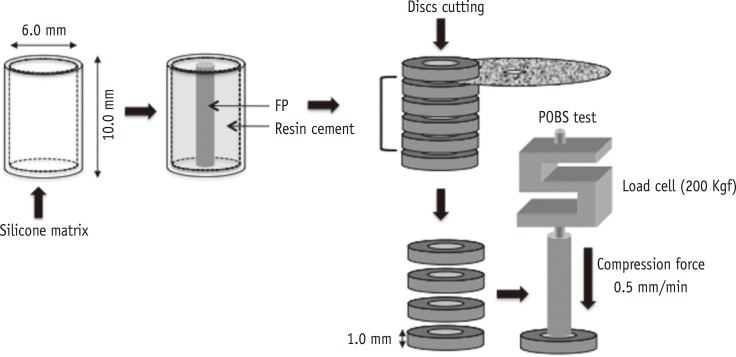
Figure 3
Photomicrography of the surface of fiber posts in different groups: (a) Control; (b) H2O2; (c) blasting; (d) NH3; (e) HMDSO. Images (a - e) show the state before adhesive application and images (a' - e') after adhesive application. HMDSO, hexamethyldisiloxane.
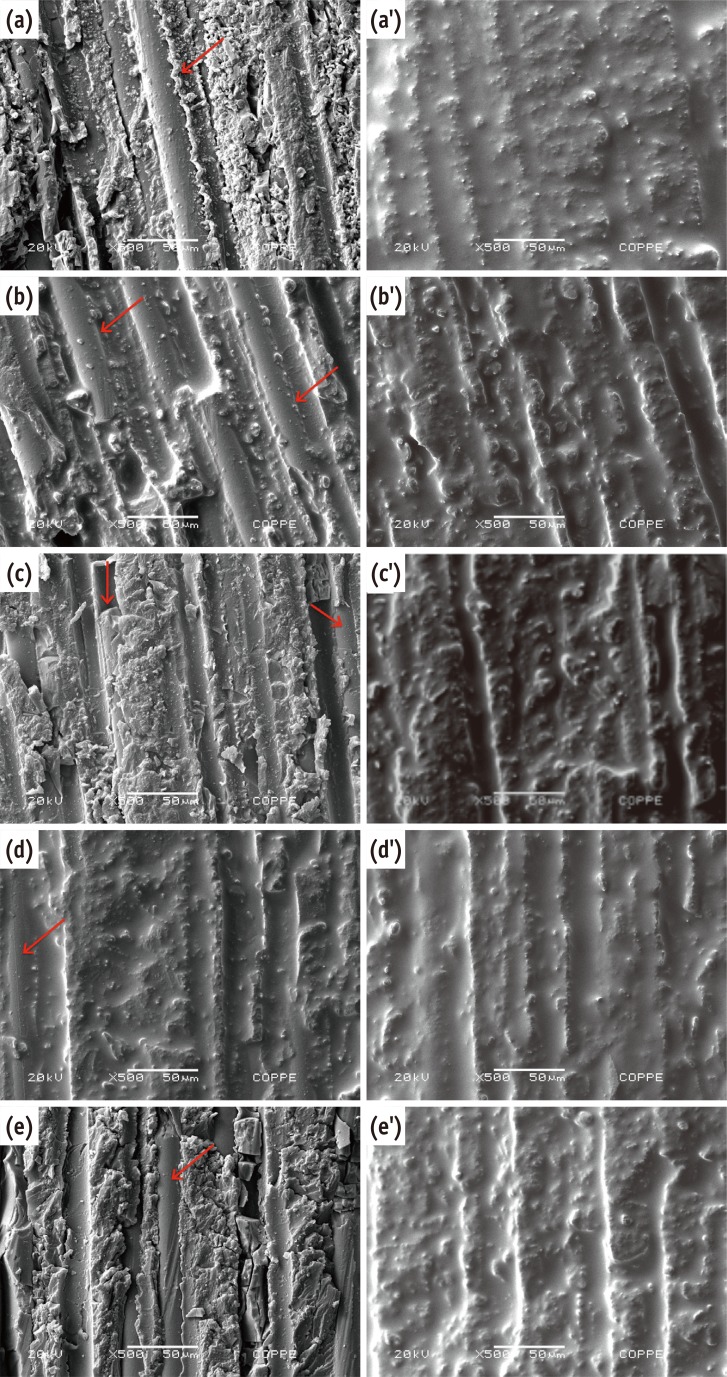
Figure 4
Fourier transform infrared spectroscopy spectra of the fiber post surface after adhesive application. HMDSO, hexamethyldisiloxane.
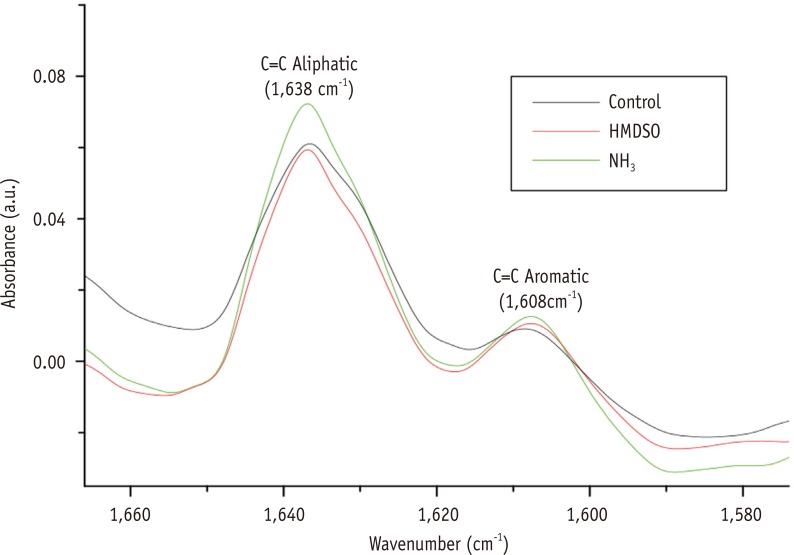
Table 1
Fiber post surface treatments
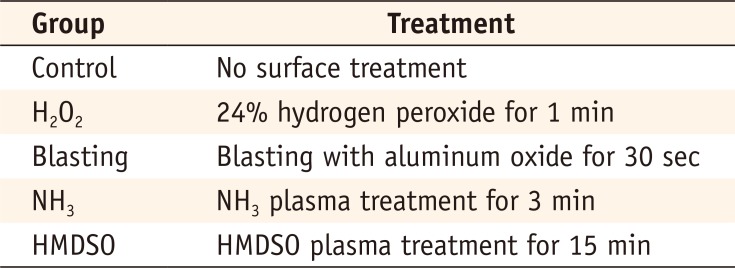
Table 2
Push-out bond strength values (mean ± standard deviation) and failure patterns of the different groups
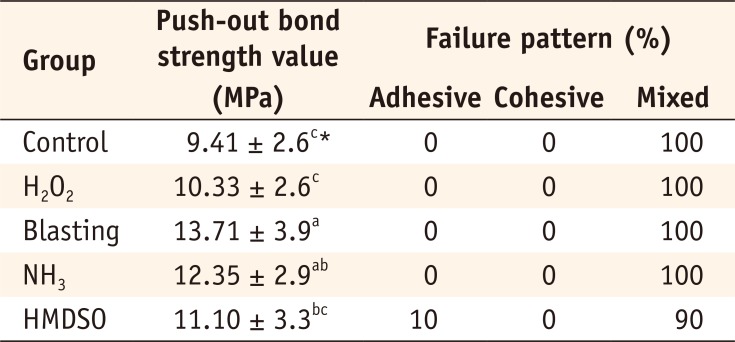
Table 3
Intensity of different functional groups normalized to that of the aromatic C=C double bond





 PDF
PDF ePub
ePub Citation
Citation Print
Print



 XML Download
XML Download